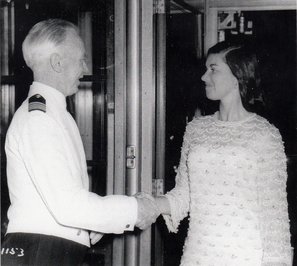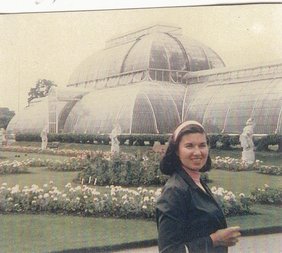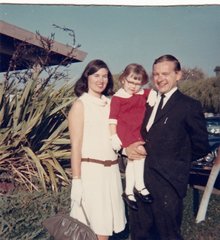 Sherrill Meeting the Ship's Captain
Sherrill Meeting the Ship's Captain
Growing up, neither Sherrill nor I had much money, but we were lucky early in our marriage when some came our way from my writing, giving us the opportunity to travel, which we'd both always wanted to do. When we weren't seeing the world, she was back at her job as a children's librarian and I was at my desk writing. We never would've dreamed that we'd be able to spend four weeks driving around the British Isles, but there we were, near the end of a month doing that. After saying goodbye to our Mini, we took a cab to the Victorian Russell Hotel in London's Bloomsbury, where Virginia Woolf and her circle once ruled. Sherrill had been heroic during the past weeks, but she was liberated from driving for the rest of the trip.
The next day, we rode the Tube out to Kew Gardens, where the huge greenhouse and the plants inside teased our imaginations. Most of them were exotic for Britain, but some, Sherrill pointed out, would have no trouble thriving in California, with its Mediterranean climate.
"But where would we put them?" I asked her.
"I'd find a place," she smiled, "if I wanted to."
Sherrill and I took turns going to plays rather than trying to find a nanny. One evening a dessert we saw on the menu in the hotel dining room intrigued us. The waiter told us to order it with the rest of the meal because it took so long to make. Dinner, however, took much longer than we'd expected. I had a ticket for the new John Osborne play at the Royal Court Theatre across town and began to wonder if I'd get there on time. Finally, I had to abandon Sherrill and Simone and rush out to a taxi.
"There I was, alone with a little girl in that huge dining room," Sherrill told me later, "when the waiter brought that big dessert covered with fancy meringue—and lit it. Everybody in the place stared at us."
"But did you like it?"
"It was okay, but I've decided that I don't care all that much for candied fruit."
One June day, Sherrill went off in a taxi to the annual Chelsea Flower Show, while Simone and I amused ourselves exploring the city. We especially liked watching all the boats on the Thames and walking among the battalions of hungry, bobble-headed pigeons in Trafalgar Square.
A classic black London cab, tall and roomy, carried us to Waterloo Station to get the boat train for Southampton and our ship back to the United States. At the station, uniformed porters snatched our luggage, made marks on it and on the luggage tags, then our cases vanished. It was like a scene in an old movie, much hustle and bustle and excitement, but, I wondered, gazing in the direction our luggage had gone, what if it turned out to be a Hitchcock story with people and things abruptly vanishing?
We had just settled ourselves in our compartment on the train when a bouquet of plump middle-aged ladies in flowery dresses blew into it and arranged themselves in the empty seats without any apparent concern about where their suitcases might be or if they'd see them on the ship. Okay, I decided, if they're not worried why should I be?
When we reached our stateroom, our suitcases were waiting for us. It was larger than we'd expected, with two portholes. The bathtub, I discovered, had faucets for salt water and fresh, both hot and cold. Before dinner, we wandered around the ship. The public rooms were all decorated with patterns of inlaid woods. I hoped four and a half days crossing the Atlantic would be enough time to explore the ship. It turned out that 1968 was the final year for the Queen Elizabeth to carry passengers on the Atlantic route. Airplanes had stolen too many passengers. An outdoor swimming pool and an informal Hawaiian-style cocktail lounge had been added so she could cruise the Caribbean when she wasn't crossing the Atlantic, but this didn't save her.
One afternoon, we left Simone in the children's playroom, presided over by a nanny and her assistant and full of wonderful toys and structures, including a model ship that kids could steer. Unfortunately, she didn't much care for any of it. The evening of the Captain's Reception, we managed a fair impersonation of being civilized, Sherrill in the dress she'd brought for the occasion, I in my best suit, and Simone her prettiest dress, vivid red and white.
Sherrill and I didn't dance that evening—or ever, really, because she'd never properly learned how. All through high school and college, she was always in the dance band—as well as in the school marching band. She played both the clarinet and saxophone. For the rest of her life, though, she could give a good critique of any band she heard and any player in it. Nevertheless, she usually forgave me for the ignorant things I often blurted about music because I wasn't musical and had the ear of a boulder.
When we reached New York, we docked next to three other passenger liners, the Italian Line's Michelangelo beside us—it was really the end of an era. The crew helped us through customs and to a taxi for our hotel. One morning, Sherrill stayed with Simone while I visited my agent. We did a little sightseeing, but after a couple of days we rode a train south to Washington D.C.. where we stayed with my aunt and uncle for two more days before getting on the transcontinental train heading west to the bay area. In that pre-Amtrak era we had to change terminals in Chicago so we could transfer trains. The double-decker California Zephyr observation cars were too tall to fit under the old bridges east of the Mississippi River. Today, these long-distance trains that give us a chance to see America and not just fly far above it are endangered by government budget cuts.
To be continued....


 RSS Feed
RSS Feed